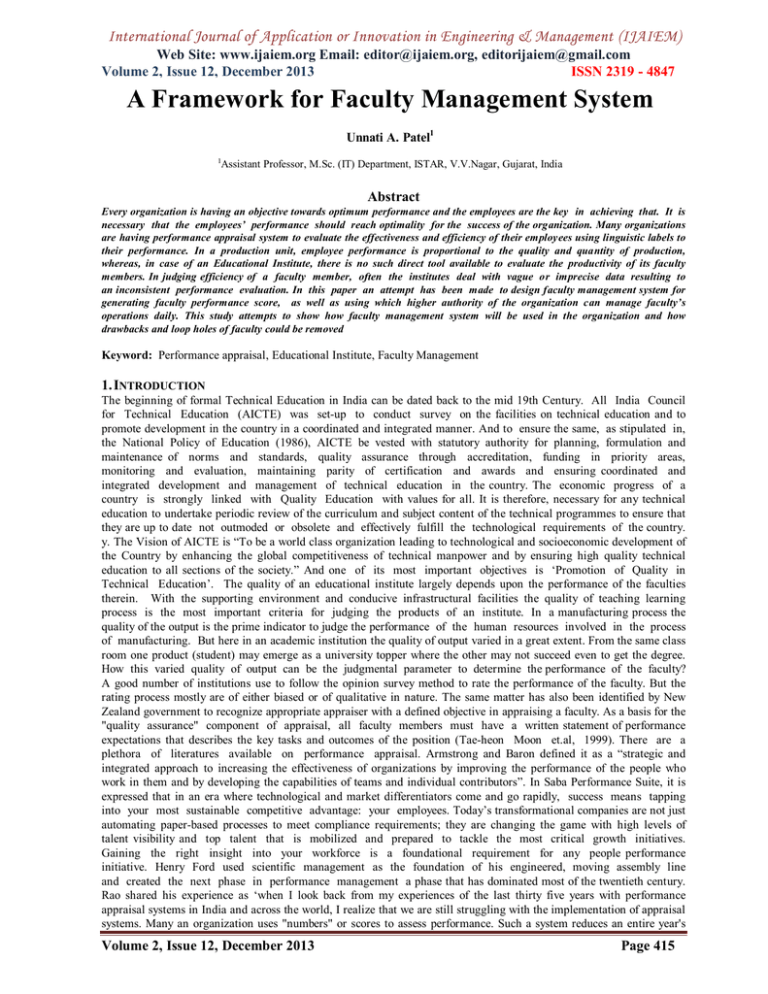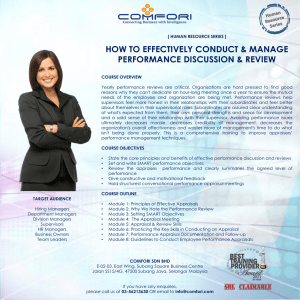International Journal of Application or Innovation in Engineering & Management... Web Site: www.ijaiem.org Email: , Volume 2, Issue 12, December 2013
advertisement

International Journal of Application or Innovation in Engineering & Management (IJAIEM) Web Site: www.ijaiem.org Email: editor@ijaiem.org, editorijaiem@gmail.com Volume 2, Issue 12, December 2013 ISSN 2319 - 4847 A Framework for Faculty Management System Unnati A. Patel1 1 Assistant Professor, M.Sc. (IT) Department, ISTAR, V.V.Nagar, Gujarat, India Abstract Every organization is having an objective towards optimum performance and the employees are the key in achieving that. It is necessary that the employees’ performance should reach optimality for the success of the organization. Many organizations are having performance appraisal system to evaluate the effectiveness and efficiency of their employees using linguistic labels to their performance. In a production unit, employee performance is proportional to the quality and quantity of production, whereas, in case of an Educational Institute, there is no such direct tool available to evaluate the productivity of its faculty members. In judging efficiency of a faculty member, often the institutes deal with vague or imprecise data resulting to an inconsistent performance evaluation. In this paper an attempt has been made to design faculty management system for generating faculty performance score, as well as using which higher authority of the organization can manage faculty’s operations daily. This study attempts to show how faculty management system will be used in the organization and how drawbacks and loop holes of faculty could be removed Keyword: Performance appraisal, Educational Institute, Faculty Management 1. INTRODUCTION The beginning of formal Technical Education in India can be dated back to the mid 19th Century. All India Council for Technical Education (AICTE) was set­up to conduct survey on the facilities on technical education and to promote development in the country in a coordinated and integrated manner. And to ensure the same, as stipulated in, the National Policy of Education (1986), AICTE be vested with statutory authority for planning, formulation and maintenance of norms and standards, quality assurance through accreditation, funding in priority areas, monitoring and evaluation, maintaining parity of certification and awards and ensuring coordinated and integrated development and management of technical education in the country. The economic progress of a country is strongly linked with Quality Education with values for all. It is therefore, necessary for any technical education to undertake periodic review of the curriculum and subject content of the technical programmes to ensure that they are up to date not outmoded or obsolete and effectively fulfill the technological requirements of the country. y. The Vision of AICTE is “To be a world class organization leading to technological and socioeconomic development of the Country by enhancing the global competitiveness of technical manpower and by ensuring high quality technical education to all sections of the society.” And one of its most important objectives is ‘Promotion of Quality in Technical Education’. The quality of an educational institute largely depends upon the performance of the faculties therein. With the supporting environment and conducive infrastructural facilities the quality of teaching learning process is the most important criteria for judging the products of an institute. In a manufacturing process the quality of the output is the prime indicator to judge the performance of the human resources involved in the process of manufacturing. But here in an academic institution the quality of output varied in a great extent. From the same class room one product (student) may emerge as a university topper where the other may not succeed even to get the degree. How this varied quality of output can be the judgmental parameter to determine the performance of the faculty? A good number of institutions use to follow the opinion survey method to rate the performance of the faculty. But the rating process mostly are of either biased or of qualitative in nature. The same matter has also been identified by New Zealand government to recognize appropriate appraiser with a defined objective in appraising a faculty. As a basis for the "quality assurance" component of appraisal, all faculty members must have a written statement of performance expectations that describes the key tasks and outcomes of the position (Tae­heon Moon et.al, 1999). There are a plethora of literatures available on performance appraisal. Armstrong and Baron defined it as a “strategic and integrated approach to increasing the effectiveness of organizations by improving the performance of the people who work in them and by developing the capabilities of teams and individual contributors”. In Saba Performance Suite, it is expressed that in an era where technological and market differentiators come and go rapidly, success means tapping into your most sustainable competitive advantage: your employees. Today’s transformational companies are not just automating paper­based processes to meet compliance requirements; they are changing the game with high levels of talent visibility and top talent that is mobilized and prepared to tackle the most critical growth initiatives. Gaining the right insight into your workforce is a foundational requirement for any people performance initiative. Henry Ford used scientific management as the foundation of his engineered, moving assembly line and created the next phase in performance management a phase that has dominated most of the twentieth century. Rao shared his experience as ‘when I look back from my experiences of the last thirty five years with performance appraisal systems in India and across the world, I realize that we are still struggling with the implementation of appraisal systems. Many an organization uses "numbers" or scores to assess performance. Such a system reduces an entire year's Volume 2, Issue 12, December 2013 Page 415 International Journal of Application or Innovation in Engineering & Management (IJAIEM) Web Site: www.ijaiem.org Email: editor@ijaiem.org, editorijaiem@gmail.com Volume 2, Issue 12, December 2013 ISSN 2319 - 4847 work to a mere figure. This figure has caused a few people to get promoted and some of them undeservingly, a few others to leave their jobs and yet a few others to walk into office every day with low interest and motivation and carry on with their jobs. Also, no two numbers are comparable in appraisals. Expectation sharing and reviewing is the most important part of performance management’ (Mehdi, 2008). 2. PROBLEM Various techniques or methods have been used by human resource management experts to evaluate the performance of an employee. E.g. presence system (using register) was being implemented and currently it is being used by most of the colleges and schools. But any faculty can make presence in place of other faculty. No verification or controlling system is there. To overcome this problem, few organizations use Finger Print verification system that can be implemented by the organization for the punctuality of the faculty. In this system when faculty enters in organization at that time he/she has to make punch on the machine using thumb impression and at the time of leaving the institute he/she has to make punch. During the time of the institute, if any faculty wants to go out from the institute for any work then he/she is required to make punch. But again this system is also having some drawbacks like faculty is going outside of the institute for his/her personal work and he/she is not making the punch. Second problem that was arise in the finger print verification system is faculty comes early in the institute, make a punch and then went at the home again at the day end he/she will come to the institute for making punch. 3. OBJECTIVE The main objective of this paper is to remove the entire above mentioned problem. And at any point of time, above authority can have information regarding all the faculties of present work. This can also be implemented along with fingerprint verification system. So it provides dual verification. Till now any research work for such kind of system is not being done. 4. METHODOLOGY One computerize system should be developed so that it can manage entries of all faculties for any institute starting from faculty entry to faculty leaving. Below are the steps for the same. 1. When faculty enters in the institute, he may be doing fingerprint punch if that system is implemented. But along with that faculty has to make its presence entry in the system and faculty time for that day will be started. 2. When faculty goes to take any lecture or lab, he/she has to make entry in the system so that at any point in time, any high authority can check which faculty can do what at this time. 3. When faculty has not load as per time table and he/she goes to library for reading purpose then he/she has to make entry in the system regarding the same. 4. If faculty goes for lunch during lunch break then also faculty has to make entry in the system. 5. After coming back from the lunch, faculty has to make entry in the system. 6. If faculty goes out of institute for his/her personal work then also faculty has to make entry in the system. 7. If faculty goes on leave then also he/she has to apply online for the leave. 8. If faculty has published or presented any paper in any national or international conference then also faculty has to make entry for the same. 9. If faculty has attended any workshop or seminar then he/she has to make entry in the system. 10. Faculty performance report at the end of the year, will be generated from the system. 5. CONCLUSION The model proposed in this paper is flexible in comparison to other models as it grabs the decision maker’s confusion and minimizes the vagueness in human (expert) decision making. All the feedbacks are taken keeping the view of optimistic, most likely and pessimistic decision making environment. The model presented in this piece of work is also taking care of crisp inputs for exact evaluation of faculty performance. This method could be applied to measure faculty performance in the different fields of education with greater efficiency. Further the use of software not only makes the data collection more easy and comfortable but the outputs error free and easy to interpret. REFERENCES [1] C. C. Yee, and Y.Y.Chen, (2009), Performance Appraisal System using Multifactorial Evaluation Model, World Academy of Science, Engineering and Technology 53. [2] http://www.performancemanagementguide.com/ [3] http://www.minedu.govt.nz/NZEducation/EducationPolicies/Schools/SchoolOperations/emp loymentConditionsAndEvaluation/PerformanceManagementSystems/PMS_5__November_1997.asp [4] Terrence, H. M. and Joyce, M. (2004), Performance Appraisals, ABA Labor and Employment Law Section, Equal Employment Opportunity Committee. Volume 2, Issue 12, December 2013 Page 416




